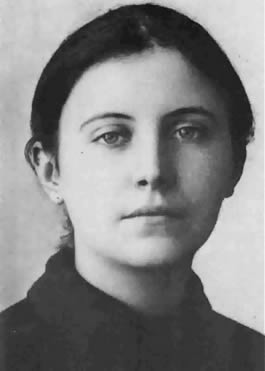The Call within Call
 Agnes Bojaxhiu, the then Mother Teresa
Agnes Bojaxhiu, the then Mother Teresa
Mother Teresa was born in 1910 into a Albanian family in the Republic of Macedonia. Teresa's mother had a special kind of love for women in distress. Teresa’s father was an active Albanian rights activist, who fought against injustice in the society. He died in 1919 when she was eight years old.
As a young girl, her imagination was stirred by stories of Yugoslav Jesuit priests who worked in distant Bengal. Teresa left home in 1928 at age 18 to join the Sisters of Loreto with the view of becoming a missionary in India. She never saw her mother or her sister again. She left her family for a most uncertain future in a land of whose language, customs and traditions she knew nothing. But young Teresa never recorded any doubts about this decision, even in her later years.
In her 20 years as a Loreto nun, first a teacher and later Principal, her life was regulated by the ringing of the school bell. The world she glimpsed from her classroom window was made up of slums and abject poverty: it seemed to be the real world, and she slowly sensed that her vocation belonged there.
She was increasingly disturbed by the poverty surrounding her in Calcutta. The Bengal famine of 1943 brought misery and death to the city, and the August 1946 Direct Action Day began a period of Muslim-Hindu violence.
The call within the call
On 10 September 1946, Teresa experienced what she later described as "the call within the call" when she travelled by train to the Loreto convent in Darjeeling from Calcutta for her annual retreat. "I was to leave the convent and help the poor while living among them. It was an order. To fail would have been to break the faith”. Though no one knew it at the time, Sister Teresa had just become Mother Teresa.
She began missionary work with the poor in 1948, replacing her traditional Loreto habit with a simple, white cotton sari with a blue border. She was alone. She had no helper, no companion and carried no money to speak of. She stepped into a city in which she had taught long years but of which she knew nothing. She taught herself to beg.
Teresa adopted Indian citizenship, spent several months in Patna to receive basic medical training at Holy Family Hospital and ventured into the slums. She set up her first school in the very slum she saw each morning outside her classroom.
It had no classroom, no table, no chair, no blackboard. She picked up a stick and before a group of curious children who had never seen the inside of a school, she began to write the Bengali alphabet on the ground. Within a few days, some rickety furniture appeared; someone donated a blackboard and chalk. Lay teachers from the Convent soon volunteered to teach. Her little school in Motijhil became reality. A tiny dispensary followed, stocked with a few basic medicines. Her disarming charm and directness moved people to want to help her.